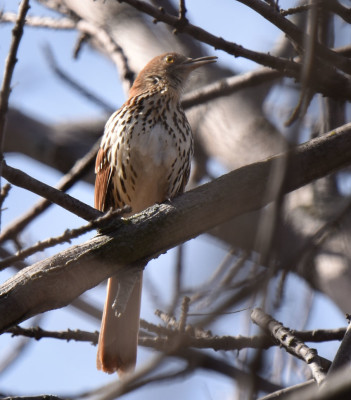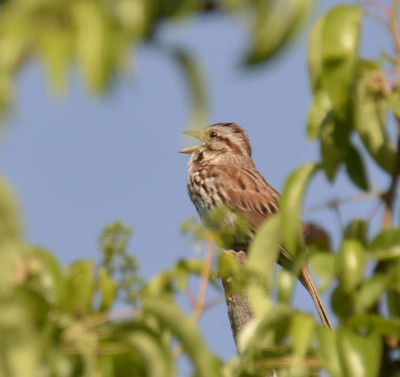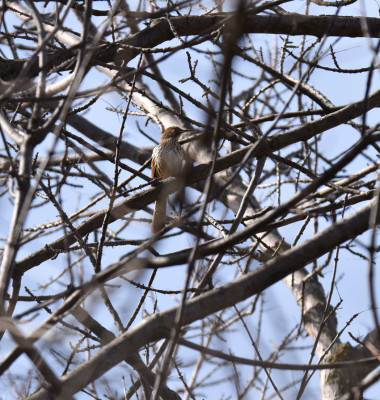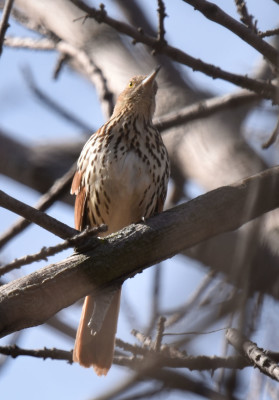I’ve been searching hard for a Brown Thrasher this April. They wing their way through the local wood lots on their spring migration. Last year, I saw what I was 95% sure was a Thrasher but I couldn’t get a photo or a good clear look so I’ve been waiting for 12 months to try again. (Wood Thrushes, Hermit Thrushes, and even female Cardinals can be mistaken for Brown Thrashers if the bird isn’t in clear view.) Finally, two days ago, I met with success.
Brown Thrashers Sift Through the Leaves for Food
Like Grackles, Brown Thrashers like to feed on the ground hunting for insect prey among the dead leaves. I can usually hear Grackles at work as they pick and toss and kick aside the leaf litter.

Can you spot the Brown Thrasher?
Even when I was watching two Brown Thrashers this week, though, I didn’t hear any noise as they worked away. You’d think something called a Thrasher would make quite a racket but these ones didn’t. Maybe the leaves were too soft? I’m not convinced because those same leaves made plenty of noise when I tried to sneak closer to the birds. Anyway, the lack of noise made it much more difficult to figure out where the birds were.
Were These the First Brown Thrashers I’ve Ever Seen?
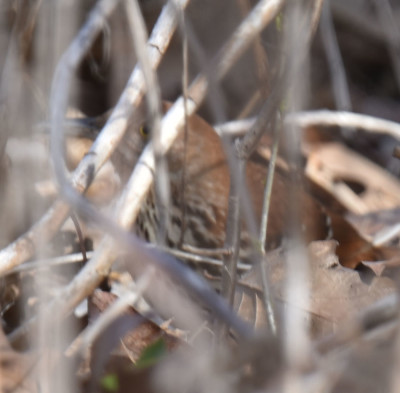
This is a closeup of the same photo. Can you find it now?
No. I had a really good look for several minutes at a Brown Thrasher when I was a teenager. It was near a creek that I used to paddle up each spring and early summer to look at Barn Swallows nesting on the underside of a small concrete bridge.
When seen in the open in good light, a Brown Thrasher is an easy bird to identify: It’s roughly robin-sized, vivid rusty red on the back and tail, darkly streaked with black on a white chest, and has a long curving black bill.
I’ve had other quick glimpses at Thrashers over the years. Now that I have a good camera and a long lens, though, I’ve been trying to get an acceptable photo of as many birds that I meet as I can.
What Big Rusty Bird Is Singing a Series of Repeated Bits of Other Birds’ Sounds and Songs?
Last year at a local park, another birder informed me that I had just missed a Brown Thrasher which had been singing for 15 minutes that morning. I silently vowed to learn what on earth their song sounds like so I would have a fighting chance of noticing one if it started singing again.
Of course I promptly forgot all about it.
But this spring, I did look up the Thrasher’s song on AllAboutBirds. Frankly, I didn’t think I could memorize it!
Fortunately, the site pointed out a key feature: Brown Thrashers are in the same family as Mockingbirds. Thrashers like to sing bits of other birds’ songs and they usually repeat each snippet twice before starting the next one. So they would sing something like: Phoebe-Phoebe, Robin-Robin, Junco-Junco.
Most of this week, I was vigilant about tracking down EVERY singing bird in the wood lot where I thought a Thrasher might likely appear. I have lots of photos of Starlings, Goldfinches, Ruby-crowned Kinglets, Song Sparrows, Robins and Cardinals to prove it.
When I did finally hear a bird singing pairs of snatches of songs, I tried to get to that area quickly and silently: not an easy task through the extremely dense underbrush that Brown Thrashers love! Of course the bird stopped singing before I got close.
At that point, I realized I didn’t even know where to look for the singer. (I’m not particularly good at figuring out where sounds are coming from: I’ve been three meters away from a Carolina Wren belting out its song and still had trouble seeing it.)
Do Brown Thrashers Sing At the Tops of Exposed Trees? In the Middle of Tree Branch Tangles? Or from Deep Inside Thickets?
Some birds, like Song Sparrows, often fly up to exposed high perches before launching into song.

Ruby-crowned Kinglet with his crest up singing from a sheltered spot.
Others, like Ruby-crowned Kinglets, may prefer to sing while hidden deep in low shrubberies or while briskly moving from branch to branch as they hunt through cedars, goldenrod and poplars.
Where should I look if I heard the Thrasher again? Up? Down?
I’d already discovered that certain dead oak and maple leaves are exactly the same colour as a Thrasher. Seeing various tangles of foliage mid-thicket had already led me to take a good dozen photos of dried leaves! So just looking for the bird wasn’t going to guarantee success even with its large size and bright colouring.
Before I got home to check the facts, I found my first Brown Thrasher singing. It was perched about half-way up a tree in among quite a few branches and twigs. In fact, it was sitting with its back to the morning sun, so at first all I saw was a light coloured chest and I wasn’t sure what I was looking at.
Fortunately, my camera seems to cope reasonably well with shooting into the light, so I got the photos that are in this article.
My bird only sang for a few seconds before flying down into another thicket. According to AllAboutBirds, it was probably a male, as they are the ones reported to sing up in the tree branches.
Where Do Brown Thrashers Nest?
I had the mistaken idea that these birds moved north to nest but when I read up on them, I discovered I was wrong. They nest throughout the eastern US and the southern part of Quebec, Ontario, and the prairies. They don’t actually make it very far north.
I highly doubt any will stay to nest in the small woodlot where I found them this spring: it’s too degraded a habitat to support large birds. I should keep an eye out locally, though, in better habitat. Maybe I could actually find a summer Thrasher!
The nests are usually in the dense shrubs they like to hunt under. The chicks also don’t stay in the nest very long. So I won’t spend time trying to find a nest, I’ll just look for the birds themselves. It’s always good to have another goal.
Related Reading
Join In
Do you have Brown Thrashers in a thicket near you? Please share your sighting with a comment.

